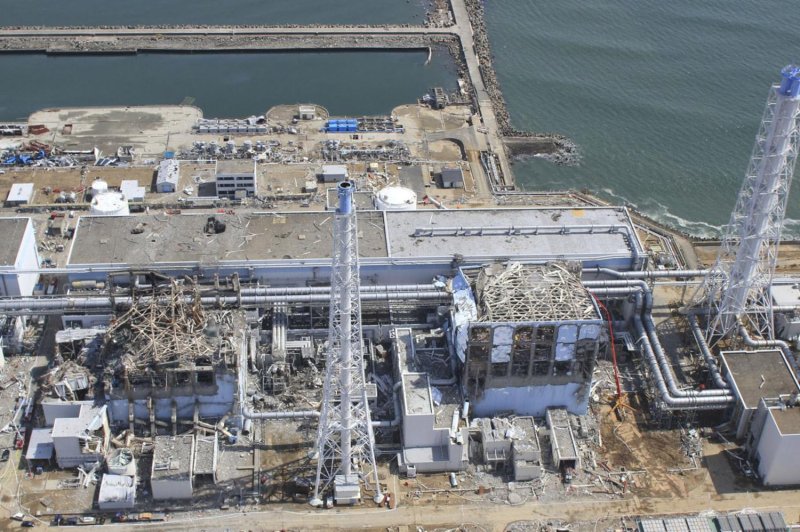The crippled Fukushima nuclear power plant in Okumamachi, Japan is seen in 2011, shortly after a twin earthquake-tsunami caused a massive meltdown. Workers using robots estimated radiation levels that would kill a human dozens of times over still found near one of the three reactors that melted down during the disaster. File photo courtesy Air Photo Service Co. Ltd./UPI |
License Photo
Feb. 3 (UPI) -- Workers have measured radiation levels that would kill a person after even momentary exposure near one of the three reactors that melted down inside Japan's Fukushima nuclear power plant.
Officials with Tokyo Electric Power Co., or Tepco, estimated nuclear radiation at 530 sieverts per hour beneath the pressure vessel at Reactor 1 that contains the reactor's core, the Japan Times reported.
By comparison, exposure to just 1 sievert of radiation can cause sterility, hair loss and increased risk of cancer. Exposure to 4 sieverts would result in a 50/50 chance of survival.
Tepco said the reading is the highest recorded since a twin earthquake-tsunami in 2011 caused the Fukushima nuclear plant to go dark, rendering it unable to cool three nuclear reactors that eventually melted down, causing the world's worst nuclear disaster since Chernobyl.
The reading suggests some of the nuclear material has leaked out of the pressure vessel and is sitting nearby. Officials said they have also uncovered a gaping six-foot hole beneath the pressure vessel, possibly caused by overheating nuclear fuel that seeped through the pressure vessel during the meltdown.
Scientists and government officials are still grappling with crafting a clean-up plan for Fukushima. The radiation readings taken this week constitute a serious setback in the effort to remove the nuclear material and dismantle the reactors.
The company is planning to deploy a special robot designed to withstand high levels of radiation to further explore a hole that has formed in the metal grating beneath the containment unit at Reactor 1, but the high levels of radiation will hamper even that effort. Officials thought they would have up to 10 hours before radiation rendered the robot, which can withstand up to 1,000 sieverts of radiation, useless. Given the levels measured this week, they will now have less than two hours to explore the inside of the reactor and begin formulating a plan to dismantle it.
Tepco has said it intends to begin dismantling the Fukushima power plant by 2021, but that process could take up to 50 years.















